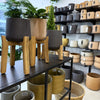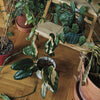Light conditions for growing houseplants
With today's rich selection of indoor plants, it is very easy to choose and buy one. But arranging for it to thrive and grow beautifully is another matter. Fortunately, you can count on us to help you choose the right plants in store and on our website, but for plant lovers who take their growing seriously, we still have these articles in our 'Green Sheets'.
Today we will focus on one of the most important conditions for plant survival, and that is sufficient light. Thanks to the light, the plant can produce sugars (energy-rich compounds), which serve as its main fuel. It makes them from carbon dioxide and water, which are simple inorganic substances. The by-product of this transformation is oxygen, which is then used by us humans. I probably don't need to go into the details of photosynthesis here, but every housekeeper should have at least a minimal idea about this topic! This will ensure that your plants will thrive and bring you joy. The very best thing is when you can find out its care requirements before choosing a plant and decide in advance if it is the right one for you. Doesn't it just work that way? That we all know that head-over-heels in love with a gorgeous maid who might be begging us to take her home? Yes, yes, you're right, so this is just the basics, ok? 😊

To determine the lighting conditions in the interior, answer the following questions.
- Which side of the world?
To begin with, try to find out on which side of the world your windows are located in the rooms, so that you know at what intensity the light falls on the plants. Do you see the sun rising from your window in the morning? So they will be placed to the east, on the other hand if you see the sunset, they will probably be placed to the west. Or use a compass, it's probably in every smartphone today...
North side
North-facing windows are normally classified as windows with low sunlight intensity, which never receive direct light. Plants that have similar conditions in their homeland, growing at low levels or directly on the ground in rainforests, will thrive here. It is, for example, philodendron, epipremnum, sansevieria, zamioculcas, aglaonema.
South side
Windows to the south provide enough light throughout the day and even intense direct light. Sometimes there can be too much direct light, for example in winter when the sun is lower in the sky. Keep this in mind when placing plants directly on a south-facing windowsill. Direct sunlight could burn the leaves. Alternatively, add at least a curtain to the window to soften the light. Plants that require a sunny place will thrive here, such as cacti, aloe vera and all kinds of succulents or peperomia.
East side
East-facing windows are perhaps the dream of every bedroom owner. The amount of direct light that penetrates through the window in the morning can be tolerated by any plant, and during the day there is enough indirect light that must really suit everyone. Here, you can place the popular African violets, arrowroots, begonias right next to the window, and shade-loving plants can also be placed further away from the window. Don't worry, east-facing windows are perfect for most plants.
West Side
The light near the western window becomes more intense and for many plants these afternoon rays can be scorching. Place plants on the windowsill that don't mind direct light, such as cacti and various succulents. There will be enough light for them on the windowsill even in the morning. Thanks to its angle, the rays of the setting sun will reach further into the room, so shade-loving plants that will be placed even 2 meters from the west window will thrive here. This can be, for example, sansevieria, aglaonema, epipremnum.

- How far from the window?
Depending on the distance from the window, the light intensity can also be determined. If we place the plant directly on the windowsill, where the sun shines all afternoon, it will have completely different conditions than a plant that is placed 2 meters from the window and does not get direct sunlight all day. Keep this in mind when choosing a plant and find out its requirements.

- Is there an obstacle between the window and the plant?
Will direct sunlight fall on the plant? Or does it stand against the wall next to the window? Do you use curtains or is there a tall tree right in front of the house? If you're still not sure how much light you have in the interior, even now you can help with an application on your smartphone that detects the light intensity, e.g. Lux Light Meter. According to the amount of light that the plants need, they can then be divided into three large groups - for sunny places; for bright places and plants that thrive even in partial shade.
Plants for sunny places
They need light with an intensity of 3000 to 5000 lux and they don't mind direct sunlight either. Such a place is directly on the windowsill or very close to the window, where there is no obstacle to the sun's rays. These plants include cacti, thickets, aloe, agave, echeveria.
Plants for bright places
They need light intensity of 3000 lux and less, but at least about 2000 lux. Such a place corresponds to a location near a window where there is still enough light, but without direct midday/afternoon sunlight. Sometimes such light is called filtered light or indirect light. Most indoor plants will appreciate these light conditions, e.g. philodendrons, monsters, epipremnum.
Plants for partial shade
These plants can get by with an intensity of around 1000 lux. If the plant does not get as much light, even a smaller amount of water in the irrigation is sufficient. Pay attention to this and before each watering, check the humidity of the substrate, preferably with your finger. These include, for example, zamioculcas, scapula, various types of ferns, sansevieria.

Take the test!
Choose a place for your plant. Step on it at high noon. See if your character casts any shadow. Is it beautifully visible with straight and clearly defined edges? So this place can be classified as sunny. If the shadow is milder, but you can still distinguish your figure without problems, then you are standing in a bright place. But if you can barely distinguish your shadow, you are standing in a semi-shaded or shady place. To be sure, you can still open the book and look inside it. Can you read it easily without added lighting? If not, the place will probably be too dark even for your plants.
How to improve poor lighting conditions?
Regular window washing at regular intervals will help to let more light into the room. Even a thin layer of dust on the glass can prevent the sun's rays from sufficiently illuminating the interior. It is also advisable to remove curtains and blinds, or at least open them during the day. If the room has skylights, the plants will appreciate it too! They are sufficiently illuminated throughout the day regardless of the direction of the world and are considered the fifth source of light (after north, south, east and west). Light painting on the walls and bright interior fittings will also provide more light in the room. During the summer, you can move the plants outside to the garden or balcony. They say that even the darkest shadow outside is still lighter than the brightest spot outside the window inside. Sunlight hits the plants outside from all sides, and together with air humidity and air flow, staying outside during the summer will make almost every roommate happy. Sometimes it also helps if we place the plant in a hanging flowerpot, especially in ground-floor apartments, where the light falls mainly on the walls and the ceiling. For this you can use, for example, our macramé curtain, available HERE in our e-shop.

Artificial light
There is another solution that perfectly replaces sunlight, especially during the winter when we all struggle with a lack of light. These are the so-called grow bulbs . These bulbs will provide the plant with a full color spectrum, so it will use it in every life cycle. By using these fluorescent lights, we can also achieve extra benefits for flowering plants, such as African violets, which will not drop their flowers. In our shop, we have SANSI Led Grow bulbs, with which we have extensive experience from our other projects and can really recommend them. You can now buy them HERE in our e-shop.
Good luck to the light and the maids!
Elizabeth Lacinová




